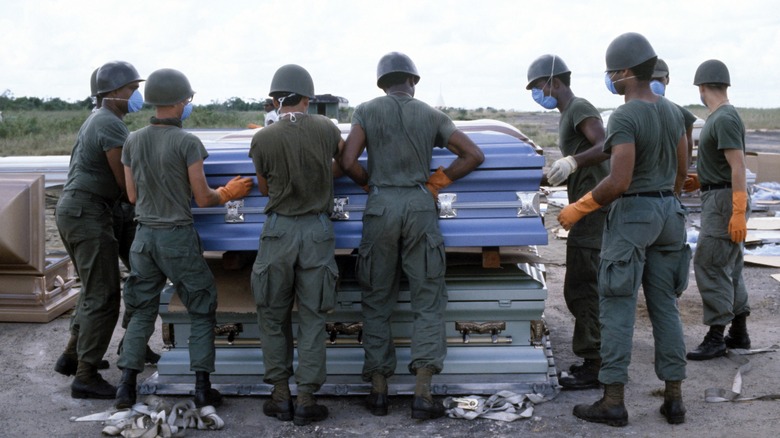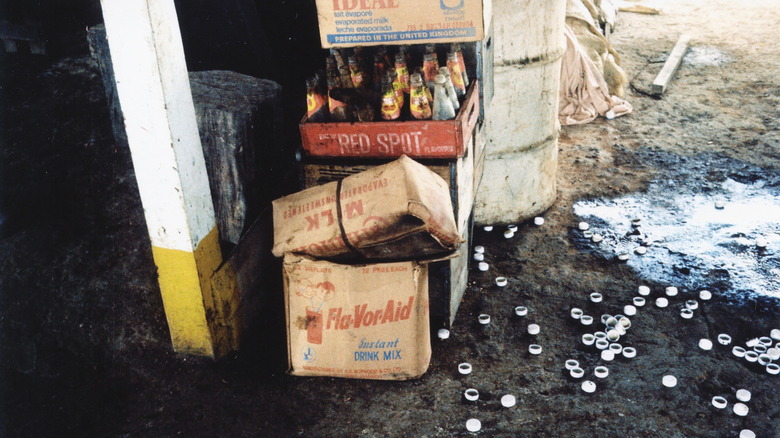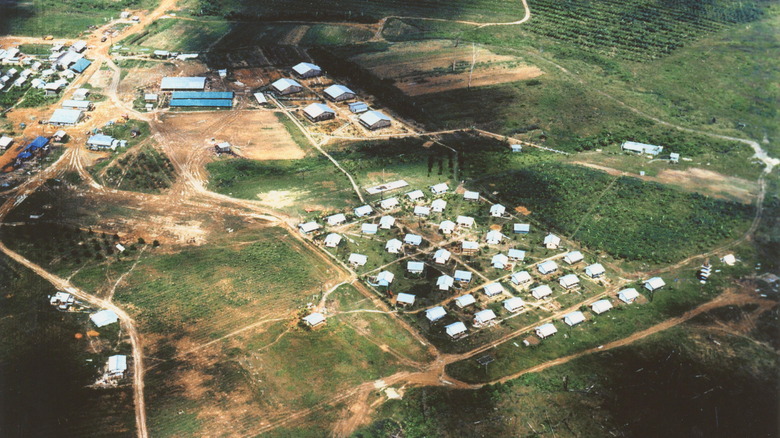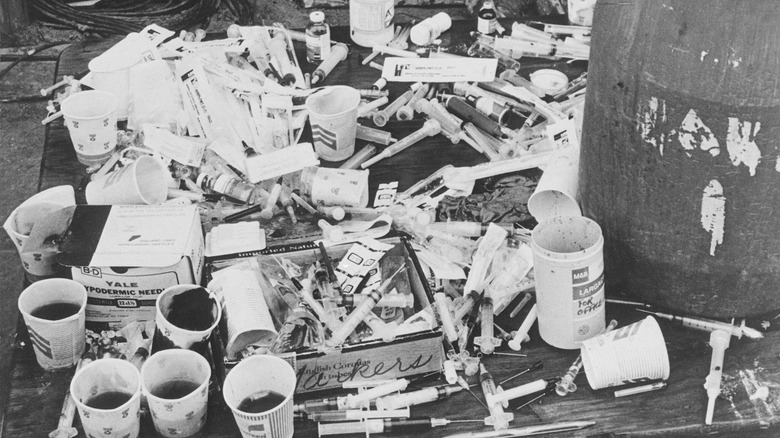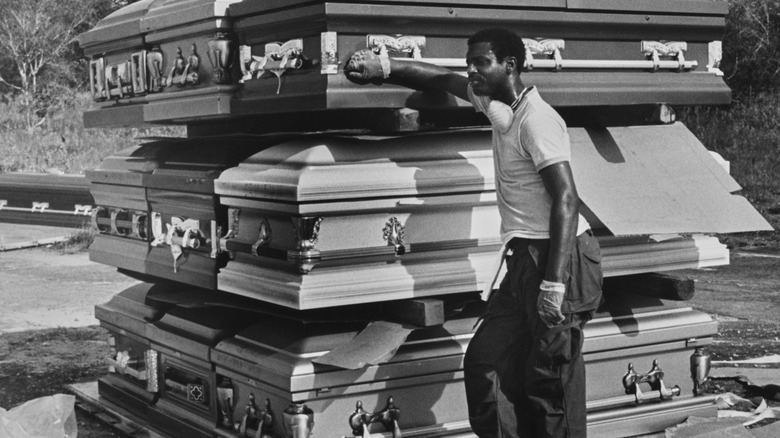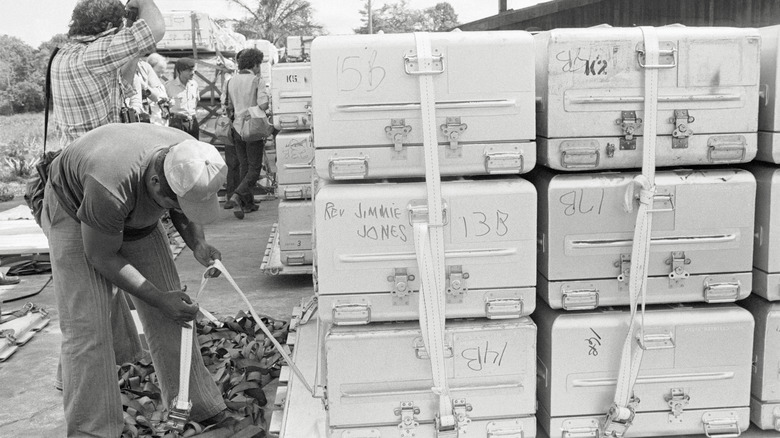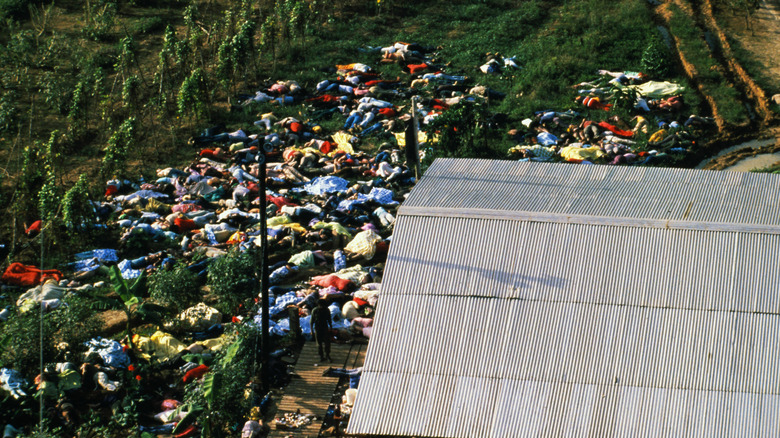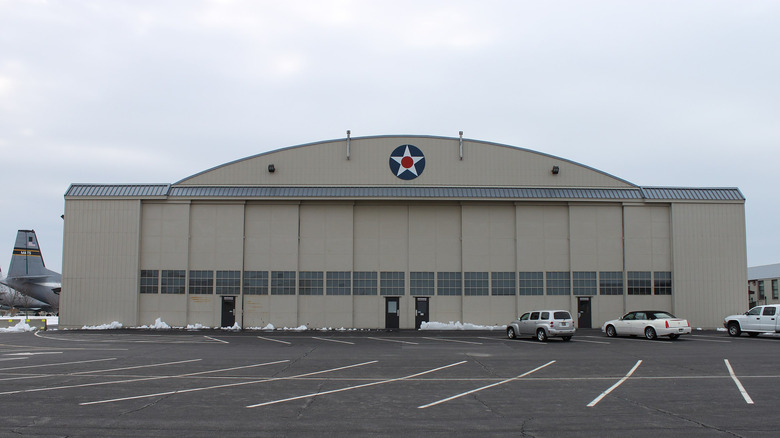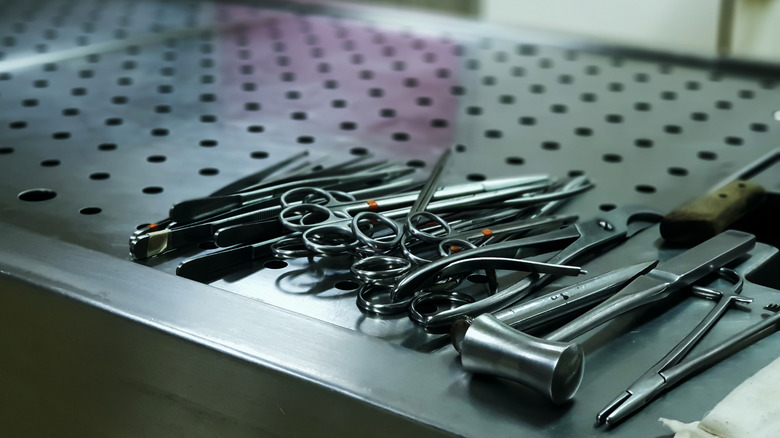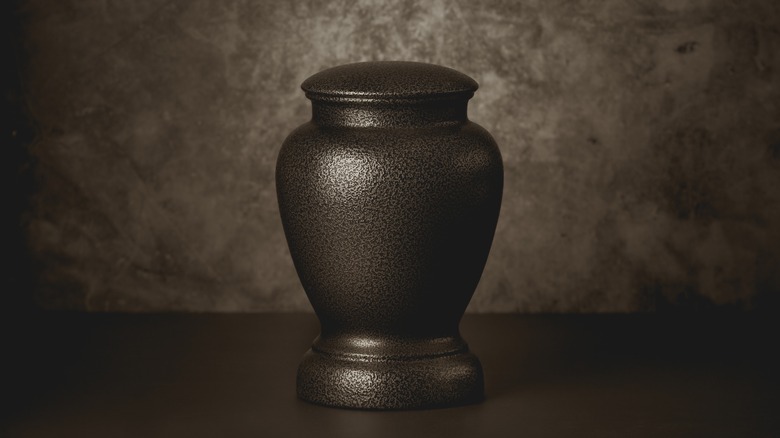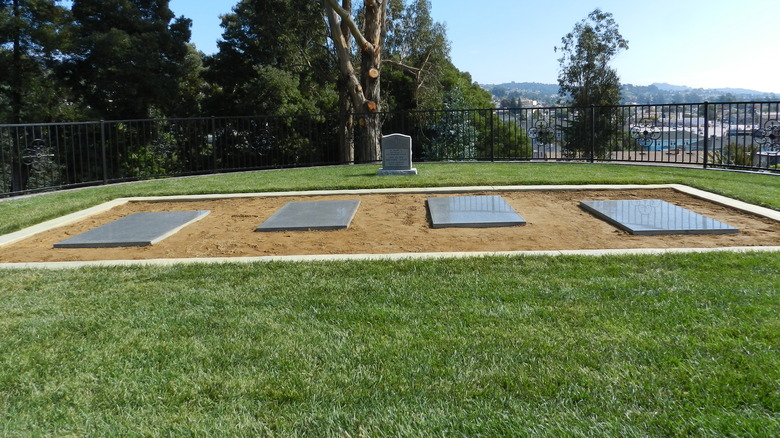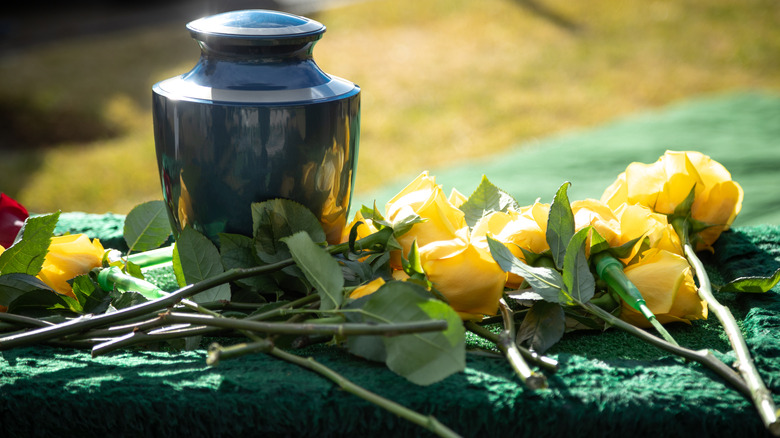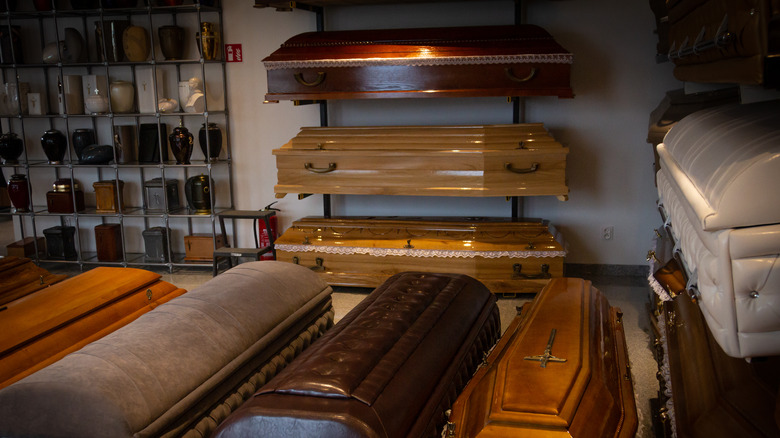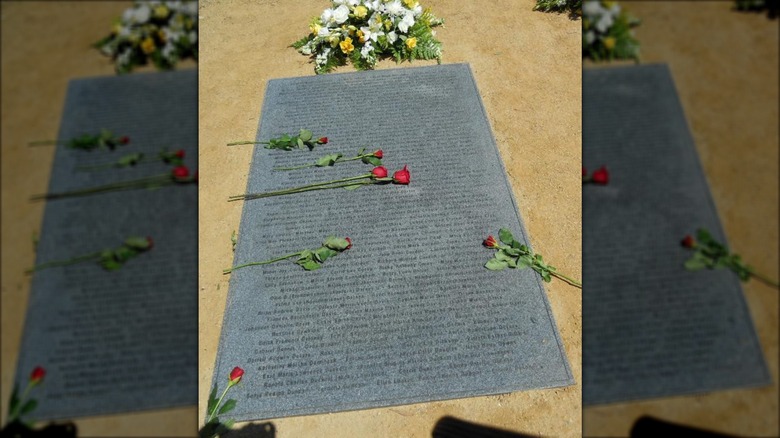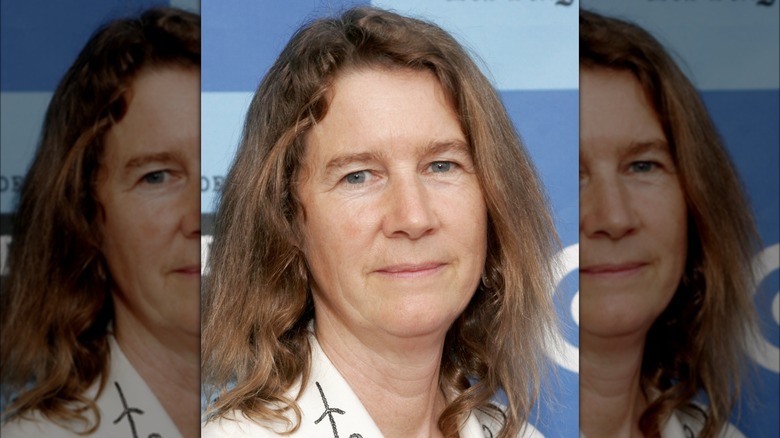What Happened To The Bodies At Jonestown?
At first, Jim Jones may have seemed like any other preacher. What became Peoples Temple started as Community Unity Church in 1954 in Indianapolis. It gained its eventually infamous name two years later, alongside a reputation for its integrated congregation, free community programs for members, and political involvement. By 1965, Peoples Temple members had moved to rural California yet remained deeply embedded in the progressive movement. However, Jones became increasingly power-hungry and paranoid, eventually leasing land from the Guyanese government to develop the "Peoples Temple Agricultural Project." A 1977 exposé published in New West proved to Jones that the wider world was out to get him.
The commune was more popularly known as Jonestown. There, Jones leaned hard into apocalyptic rhetoric and rambling speeches, which were often played on a practically endless and inescapable loop at the camp. He also held macabre rehearsals for mass suicide, telling commune members that self-annihilation was better than facing an FBI raid. On November 18, 1978, Jones came through on his rhetoric, with more than 900 followers ingesting poison in a mass suicide. What happened next with their bodies caused even more controversy and confusion.
More than 900 people died at Jonestown
After United States Rep. Leo Ryan was shot to death near the commune on November 18, 1978, Jim Jones gathered the members of Peoples Temple around him and said that it was time to commit what he termed "revolutionary suicide." This time there was no drill, as commune members were asked — or perhaps forced — to consume a deadly mixture of sedatives, cyanide, and Flavor Aid (not Kool-Aid, as imperfect cultural memory has it). As survivor Odell Rhodes told The Washington Post in 1978, infants and young children were given the concoction first. With a toll of 304, children represented nearly a third of all the dead at Jonestown. Rhodes himself survived by hiding beneath a building, waiting a few hours, and then walking five miles through the jungle to the nearest town.
At the commune, 907 are reported to have died from cyanide poisoning. Two people, Jones and nurse Annie Moore, died from gunshot wounds. Five were shot at the local airstrip, including Ryan, defector Patty Parks, photographer Greg Robinson, and NBC employees Don Harris and Bob Brown. In the capital of Georgetown, Sharon Amos and her three children also died to fulfill Jones' directive.
Bodies remained at the commune for days
Technical Sgt. Wayne Dalton recalled that survivor Odell Rhodes, who walked through the jungle to the settlement of Port Kaituma, was one of the first to tell Guyanese neighbors what had happened. As Jonestown was populated almost exclusively by Americans, the U.S. government assumed most of the responsibility for managing the remains. However, it took two days for military aircraft to reach the site and begin transporting bodies.
During that time, remains were left in place in the heat and humidity of the tropical climate. As far as military personnel sent to the site were concerned, this was disastrous. In just a short period, bodies had entered an advanced stage of decomposition, to the point where transferring them into body bags became a gruesome task. Many service members, as well as others who arrived at the commune in the days after the tragedy, reported that the stench was all but impossible to forget. Back-and-forth exchanges between the U.S. and Guyanese governments added to the delay.
Oddly, as medic Jeff Brailey wrote in his recollection of the Jonestown response, "The Ghosts of November," buzzards avoided the mass of bodies. Perhaps, he speculated, the animals understood that the remains were loaded with cyanide and avoided the scene.
First responders found possible evidence of murder
Though many sources indicate that some portion of the victims at Jonestown participated willingly when asked to drink cyanide and sedative-laced Flavor Aid, Guyanese pathologist Dr. Leslie Mootoo and other first responders found evidence to the contrary. In 1978, Mootoo told The Chicago Tribune that, after personally examining remains on site, he believed most people had been forced into their deaths (via The New York Times).
The evidence included puncture wounds consistent with hypodermic injections, which Mootoo believed he had found on at least 70 sets of remains. These marks were reportedly discovered in places that were all but impossible to self-administer, such as at the back of an arm or between an individual's shoulder blades. Hypodermic needles were also found scattered at the scene. Furthermore, survivor Odell Rhodes told The Washington Post that he witnessed less-than-enthusiastic commune members who were pushed to consume the drink by armed guards. And, most tragically of all, responders encountered the horrific sight of young children who could not have willingly agreed to participate in Jones' last order.
U.S. military personnel were tasked with cleanup
According to Sgt. David B. Netterville, he and other military personnel who initially responded to the scene at Jonestown believed that about 400 individuals had died, with the rest of the commune hiding in the dense jungle nearby. However, as service members began clearing the remains, they realized that more dead were beneath the first layer. The grim count grew higher by the day.
But, given that first estimation, many assumed that not everyone had died. Technical Sgt. Wayne Dalton recalled that Jones' cabin contained plans outlining an escape into nearby Venezuela. As a result, helicopters were called in to fly over the proposed route and play commands to presumed fugitives to make their way out of the jungle. However, almost no one emerged, and it eventually became clear that nearly everyone at the Jonestown site had died.
Faced with a nearly incomprehensible amount of death and the reality of moving seriously decomposed remains in the field, many service members faced trauma that would haunt them for years to come. Some reported trouble sleeping and were particularly disturbed by the sight of many young children who had died at Jonestown.
The logistics of moving remains was complicated
Patricia Edwards, a civilian Air Force employee who managed the details of the recovery effort, told TIME that the logistics of the work could be overwhelming. First, there was the sheer number of the dead. Besides the emotional toll faced by responders, the fact that they had to collect, attempt to identify, and transport over 900 bodies from Guyana to the U.S. was staggering. What's more, they were in a serious time crunch. According to Edwards, personnel were given only about a week to clear the site when, under other circumstances, three weeks would have been standard.
To support the mission, Edwards and others had to essentially construct a military base on short notice in a rural area of Guyana. Professionals needed to be present to examine and treat remains. Others had to type documents and process the living individuals who moved in and out of the base. Workers had to be transported in to provide basic services like regular meals for others. And, of course, someone had to arrange for the many, many body bags and aluminum containers that acted as caskets for the hundreds of bodies. Survivor Odell Rhodes was also escorted back to the site, where he worked with Assistant Police Commissioner Skip Roberts to identify the remains of 183 people he recognized.
Identifying the dead was complicated
Figuring out who had died at Jonestown proved to be a monumental task. First, there were hundreds of bodies and only a short amount of time allotted to responders amid difficult conditions. Then, there was the weather. By the time U.S. military personnel made it out to the remote jungle site and began transferring remains into body bags, decomposition had not just set in but had become advanced. Some remains were so far gone that responders had a difficult time keeping them intact while moving them into body bags, much less worry about visually identifying anyone.
A small number of individuals, however, were easy to connect to a name. Jim Jones was found where he often was during life at Jonestown — on stage, apart from the crowd. He was dead of a gunshot wound and, like others, had entered an advanced stage of decomposition, but was otherwise identifiable.
Other factors further complicated the process of connecting names to remains. When it came to fingerprinting, a significant number weren't eligible. About a third of the dead were children or infants who wouldn't have given clear fingerprints and who would not have had fingerprint records, to begin with. Meanwhile, identification tags applied at the scene got wet from rain and humidity, making the ink on them all but impossible to read. And, because clothing was often shared, name tags found on garments were practically useless.
Remains were flown to Delaware
Though the U.S. military had assumed responsibility for the remains of Americans in Jonestown, no one was initially sure where the bodies would end up. Originally, there were plans to bury the remains in Guyana, but officials balked at the idea of hosting what would surely become a notorious gravesite in their country. Ultimately, officials decided that all remains would be flown to Delaware. But why not California, where many family members of the deceased lived? That was precisely the point. One official reportedly claimed that the physical distance would keep family from flooding the operation and making an already complicated task even more byzantine.
According to the recollection of Sgt. David Netterville, remains were first placed in body bags. Then, graves registration personnel from the U.S. Army flew remains into Georgetown, where they were transferred into aluminum containers. From there, they were flown to Dover Air Force Base in Delaware and stored in hangar 1301.
[Featured image by GB fan via Wikimedia Commons | Cropped and scaled | CC BY-SA 3.0]
Only a small number of autopsies were performed
Though Guyana's chief pathologist Dr. Leslie Mootoo was on-site at Jonestown and performed examinations on many of the remains, full autopsies were not conducted until bodies had been transported to Dover Air Force Base in the U.S. Then, only seven were conducted. Two individuals were randomly selected, while the families of four requested autopsies. Only one body was specifically singled out by the government to undergo a postmortem examination: that of Jim Jones. All autopsies took place on December 15, 1978, nearly a month after the deaths, and were conducted by military pathologists.
The results were all but useless. Findings confirmed that most had died from ingesting cyanide, while Jones and close associate Annie Moore appear to have died from gunshot wounds. But the advanced decomposition made more detailed examinations difficult. Moreover, as some remains had been embalmed in an attempt to slow the decay, some evidence was likely destroyed by the chemicals and embalming techniques employed in the process. Some remains may have also been splashed with kerosene in an attempt to eradicate maggots, a move that may have damaged otherwise usable fingerprints.
Some remains were not claimed
For families, recovering the bodies of loved ones who died at Jonestown was no easy task. Military officials reportedly choose Dover AFB as a staging location because it put distance between them and California-based families. Dover is also a key mortuary location for the military and, as family member Rebecca Moore noted, conveniently close to Washington, D.C., and far from sympathetic crowds in San Francisco.
The military also charged transport fees for remains that came out to almost $500. Families were also expected to cover the costs of traveling to Delaware. Moreover, claiming an association with Jonestown and its notorious "cultists" carried a serious stigma, while some cemeteries feared becoming pilgrimage sites or unwilling sideshow attractions. Because of these barriers, some simply chose to leave bodies at the local funeral homes where they had been deposited. It was then left up to funeral directors to decide how to dispose of remains, sometimes without any direction from families.
Many Peoples Temple members were buried in Oakland
In 1979, 410 unclaimed bodies from Jonestown were buried in a mass grave in Oakland, California. Buck Kamphausen, who owned the Evergreen Cemetery that now hosts the mass grave, claimed that he was helping out people who had faced discrimination after they had been labeled as cult members. After studying how other cemeteries dealt with mass burials, he directed a crew to excavate a hill in the cemetery. The cut into the hill allowed them to place a large number of burial vaults and caskets into the grave in a stepped pattern.
Even so, later burials had to be placed next to the original site, which was simply too full to accept any more interments. Fielding McGehee, whose nephe-in-law and two sisters-in-law died at Jonestown, told Rolling Stone that there is only a light layer of earth on top of the mass grave, making additions like other burials or a heavy memorial stone ill-advised.
[Featured image by Mercurywoodrose via Wikimedia Commons | Cropped and scaled | CC BY-SA 3.0]
Other remains were quietly buried or scattered
Of the bodies that were claimed, most were buried or cremated with little ceremony by families. Sisters Annie Moore and Carolyn Layton were cremated and their ashes quietly interred in Davis, California. Layton's young son, Jim Jon "Kimo" Prokes, the biological child of Jim Jones, is presumably buried with many other unidentified minors in the mass grave set aside in Oakland. Jim Jones' wife, the long-suffering Marceline, was buried in Richmond, Indiana, alongside her parents, as well as two of her children who also died at Jonestown, Agnes and Lew Eric.
Jim Jones, the leader of Peoples Temple who was arguably responsible for the entire massacre, was perhaps subject to the most hushed end. In Dover, Torbert Funeral Chapels was directed by Jones' family to cremate his body and scatter the ashes over the Atlantic Ocean. Speaking to Delaware Online, funeral director Bill Torbert Sr. said that he and a friend took a small airplane and, once they were about a mile from the coast, simply scattered the ashes into the cold air.
Cremated remains were abandoned in a funeral home for decades
In Dover, local funeral directors who had been tasked with managing unclaimed remains found themselves in an awkward situation. Some families simply stated that they wouldn't be claiming bodies and offered no further instructions. Moreover, the state of Delaware offered no guidelines for proceeding from there. That's likely how the defunct Minus Funeral Home was found to be storing the cremated remains of 38 individuals in 2014, including nine victims from Jonestown. Five other sets of remains were unlabeled, though investigators doubted they belonged to members of Peoples Temple. The funeral home closed after its owner died in 2012.
Dover funeral director Bill Torbert Sr., who oversaw the cremation of Jim Jones and the disposal of his ashes, spoke in defense of fellow director Edward Minus Sr. Torbert told Delaware Online that holding onto cremated remains indefinitely was the ethical thing to do, especially if family members showed up decades later seeking to claim the remains. The fact that family members didn't want to claim remains or didn't know they were there was not, in his opinion, Minus' fault.
In October 2014, five of the Peoples Temple individuals recovered in the Minus Funeral Home — Tony Walker, Irene Mason, Wanda Bonita King, Ottie Mese Guy, and Ruth Atkins — were buried in the mass grave containing more than 400 Jonestown victims in Oakland, California. The other four were claimed by family members.
A memorial placed near the mass grave became contentious
Figuring out how to mark the grave site of Peoples Temple members in Oakland's Evergreen Cemetery proved to be tricky. In 1979, a San Francisco group known as the Guyana Emergency Relief Committee arranged for a small marker to be placed on-site, but its briefness and lack of names proved troublesome for grieving friends and family. Two more stones were set in place in 2008 but only listed some of the dead. Finally, in 2011, four large monuments containing all of the names of the dead were unveiled by the Jonestown Memorial Fund (which included one of Jim Jones' surviving sons, Jim Jones Jr. as a committee member).
However, some took stock of the list and were aghast to learn that it was a little too complete. The memorial included a line dedicated to James Warren Jones, but the more formal name for Jim Jones hardly made it easier for some. Jynona Norwood, who claims to have lost more than 20 family members in the Jonestown tragedy, quickly sued. However, the lawsuit was dismissed in 2014 along with an appeal a yar later, and another commemorative stone was erected at the site in 2018.
[Featured image by Symphony999 via Wikimedia Commons | Cropped and scaled | CC BY-SA 3.0]
Some family members were incensed at how bodies were handled
For some family members of those who died at Jonestown, the long path the bodies took from the compound in Guyana to an Air Force base in Delaware, to graves or family members, was agony. Rebecca Moore, sister to Annie Moore and Carolyn Layton, wrote that the U.S. government was criminally lackadaisical in its investigation. From her perspective, bodies were treated more as problems than the remains of individuals who required care and justice. She further suggested that perhaps the demographic makeup of the members — many of whom were Black and also progressive leftists with little money or clout — contributed to this neglect.
Moore took particular exception with the mishandling of forensic evidence and the scant number of autopsies. Many blamed the Guyanese government for passing on its normal autopsy rules in its haste to rid itself of troublesome American corpses. Others pointed to the U.S. government's own haste in the wake of the tragedy, exacerbated by confusion over who, exactly, was supposed to be in charge of the bodies.
